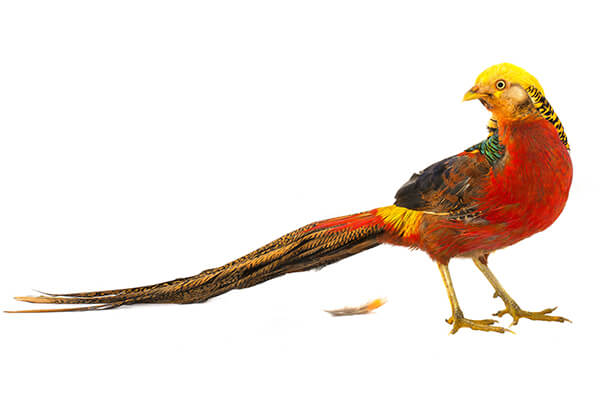
| Kingdom | Animalia |
| Phylum | Chordata |
| Class | Aves |
| Order | Galliformes |
| Family | Phasianidae |
| Genus | Chysolophus |
| Species | C. pictus |
| Niche | Forest Gamebird |
| Length | 35-41 in (90-105 cm) |
| Weight | 1.21 lbs (550 g) |
| Lifespan | 5-6 years |
| Social Structure | Monogamous |
| Conservation Status | Least Concern |
| Preferred Habitat | Forests |
| Average Clutch Size | 8-12 eggs |
| Main Prey Species | Berries, seeds, leaves, insects |
| Predators | Foxes, wildcats, large rodents, raptors |
The Basics
The Golden pheasant is a small game bird native to the forests of western China, but naturalized populations exist throughout the world. Weighing about 1.4 lbs (630 g) with a wingspan of about 28 in (70 cm), it is named after the male’s golden crest and is also known as the Chinese pheasant and Rainbow pheasant.
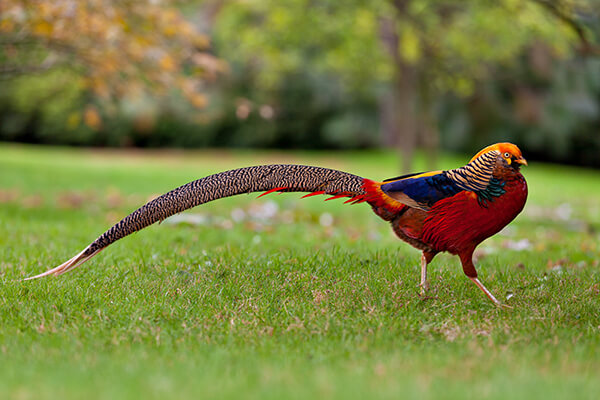
The adult male is approximately 35-41 in (90-105 cm) in length. More than half of this length is its tail. It is very distinctive and colorful, with a golden crest and rump along with other bold colors including red, mahogany, blue, purple, yellow, and black. The female is smaller, about 24-31 in (60-80 cm) long, with much less elaborate black and brown feathers and a shorter tail. Both males and females have yellow legs and beaks.
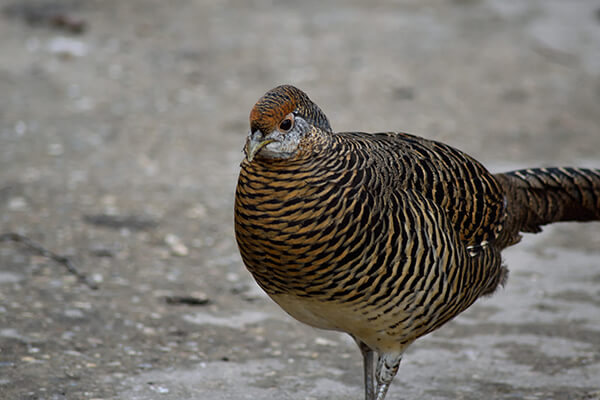
Much like chickens, Golden pheasants have the ability to fly short distances. However, they generally spend their time on the ground running. Here they feed on seeds, grains, leaves, berries, and various insects. Their main predators are humans but are also prey for foxes and wild cats. Large rodents and other birds will also prey on Golden pheasant eggs if given the opportunity.
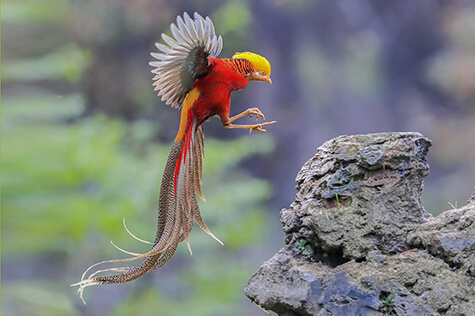
Females generally lay about 8-12 golden-brown eggs that take about 22 days to hatch. Young are independent in just 14 days and it takes about two years for them to become reproductive. In the wild, Golden pheasants can live more than 5 years, although most won’t make it to the age of 3. In captivity, some individuals have been known to live for more than 20 years.
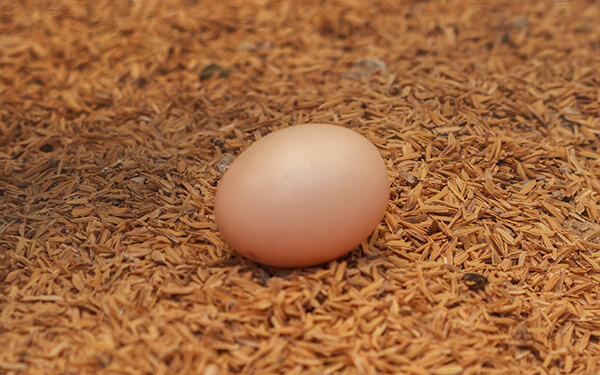
Males and females often form monogamous pairs, meaning that they mate only with each other for their entire lives. However, some males have been observed to be polygamous, sometimes forming small harems of females. Although populations are currently in decline, it is listed as “Least Concern” by the IUCN.
Surprisingly, the Golden pheasant is not the most colorful or elaborate species of pheasant, eclipsed by the Impeyan pheasants, the Chinese monal, and Horned pheasants (Tragopan spp.). In China, where Golden pheasants have been kept in captivity for more than 300 years, they are seen as a sign of good luck and prosperity.
Fun Facts about Golden Pheasants!
Despite male Golden pheasants’ bright plumage, they are relatively difficult to observe in their dense forest habitat, and therefore relatively little is known about their behavior. However, their courtship would be hard to miss.
The Dancing Pheasant
Like many birds, the Golden pheasant has an elaborate courtship display. The male, with its colorful plumage and long tail, dances for the female. He will usually expand his neck feathers out across his beak, revealing an elaborate striping pattern of alternating colors. At the same time, he will make a high-pitched metallic sound, seemingly pulling out all the stops to impress the female.
Ruffed Family
The Golden pheasant is one of only two species in the genus Chrysolophus, the other being the Lady Amherst’s pheasant (C. amherstiae).
It is the ability to expand and move their neck and cheek feathers – their ruff – across their faces like a cape that sets them apart from some 50 other species of pheasants. This is an example of sexual selection: when natural selection occurs based on a potential mate’s preference that promotes an evolutionary adaptation. Effectively, the female is trying to select the ‘best’ male to mate with. Over thousands or even millions of generations, this selection can bring about very distinctive traits as males continue to compete for access to mates.
Analogous traits have formed in other pheasant species such as the Argus pheasants of the genus Rheinardia and Argusianus. These southeast Asian species are known to carry long feathers covered with eye-like patterns they can make to appear to ‘revolve’ as the bird lightly shakes these feathers. Another more well-known and elaborate feather display belongs to the male peacock, which displays its huge fan of feathers to the female in an almost psychedelic manner. Interestingly, peacock feathers also include an eye-like pattern.
Rough Family
Generally speaking, pheasants are not highly aggressive. However, sometimes in the presence of hens males will fight each other to death while competing for the ability to mate. The females often seem largely unperturbed by the violence. As you can see, it is not only pretty feathers that a female may select for in a male. Size, speed, and strength seem to also matter as well.
